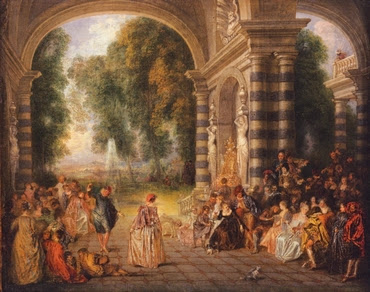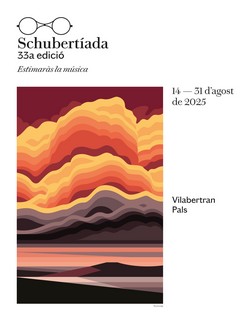
Pleasures of the dance - A. Watteau
Few weeks ago I attended as a listener to one of the masterclasses in Lied for duos organized by the LIFE Victoria; the Professor was Iain Burnside. I shared my impressions about the class in an article on the online cultural magazine Núvol, but I kept the most specific comments about Art Song for this post. I rearrange my notes and I chose among those discussed issues the following three:
- The poem. The Professor recommended the singers to work with the text without music, just the poem: reciting out aloud, paying attention to where they pause or which words they emphasize, internalizing it, taking care of their pronunciation (ah, vowels, how tricky they are when we are learning a language!). In short, as Iain Burnside said, to play with the words. He also recommended paying attention to the context of the poem; the specific example was Clair de lune by Verlaine, a poem from his Fêtes galantes, inspired by the paintings by Watteau.
Of course, it's also essential the meaning of the poem: what’s your role when singing a song? I don't thing it's easy for a young female singer to put herself in the shoes of a 19th century novice. It was also interesting to notice how puzzled a singer was when Burnside asked him about the moon. Is the moon good or bad? (it was related to a verse from a Brahm's song: Es glänzt der Mond nieder, The moon shines down). We, 21th century people, don't know anything about darkness, even less if we live in cities! City nights are filled with light so if there is moon or it isn't is just an aesthetic question. I wonder if one of the reasons why so few young people attend song recitals is because that (natural) absence of context, a lack of cultural knowledge to feel some affinity with Art Song. A journey that some people do in a short time and others, like most of us, need more years to cover. - The singer’s relationship with the public. Professor Burnside insisted that singers maintain a good posture while singing, look at the audience, not at the floor and keep their eyes open, because the audience has paid for being there and devote their time to them. As I heard those recommendations I thought of some famous singers who skipped their class and missed that lesson. I'm talking about singers that I like so much that I don’t take into account they can't stay still, in fact I am just fully aware of this later. However, I know people who get really nervous with so much action on stage. I hope the young singers will remember these tips for a long time.
Burnside also talked a lot about smiling. Every time a happy song was analyzed, the Professor told the singer that he or she should smile. Not a fake smile but a true one that comes from the inside and can be heard in the voice. Aren’t you sure that smiling can be heard? When talking on the phone, don't you hear the other person smiling? Yes, smiling changes the voice’s colour. Moreover, Iain Burnside, unaware, answered something I’ve wondered for a long time, which is if the singer receives something from the audience. He did it when he told a singer, referring to someone present at the class: look what you are missing when you don't look at the audience. Look at her smile and you feed off the energy she's sending you! - The relationship between the pianist and the singer. We have already mentioned more than once that the pianist’s task is not just about playing his part perfectly; they must also look after the singer. If the singer doesn't feel comfortable the piano should wrap him up. Burnside was very clear: “we pianists must be Coco Chanel”. I really like the idea, dress the singer but not with any clothes, be Coco Chanel!
Another important issue is the balance between the volume of the piano and the voice. How does the pianist realize he's playing too loud? Obviously, “when he doesn't hear the singer” isn't a good answer, in that situation he's blocking the voice altogether. “The pianist plays too loud when he can't hear the consonants”. Of course! My déformation professionnelle came to help me and I visualized the speech waveform, with the vowels carrying most of energy and consonants with lower levels. The other question that came up was how the singer warns the pianist he's playing too loud. There are two answers: the subtle way, singing softer; the more direct way, pulling one step away from the piano (or, I imagine so, any other agreed movement).
Many more things were discussed but, as I told you before, I chose for you what I thought was more interesting, otherwise the post would have been even longer. To end up, we are listening to one of the songs we listened in class, Clair de lune, Op. 46, no. 2 by Fauré, with a poem by Verlaine, sang by Ailish Tynan accompanied by Iain Burnside.
Clair de lune
Votre âme est un paysage choisi
Que vont charmant masques et bergamasques,
Jouant du luth et dansant, et quasi
Tristes sous leurs déguisements fantasques!
Tout en chantant sur le mode mineur
L'amour vainqueur et la vie opportune.
Ils n'ont pas l'air de croire à leur bonheur,
Et leur chanson se mêle au clair de lune,
Au calme clair de lune triste et beau,
Qui fait rêver, les oiseaux dans les arbres,
Et sangloter d'extase les jets d'eau,
Les grands jets d'eau sveltes parmi les marbres.
Your soul is a chosen landscape
charmed by masquers and revellers
playing the lute and dancing and almost
sad beneath their fanciful disguises!
Even while singing, in a minor key,
of victorious love and fortunate living
they do not seem to believe in their happiness,
and their song mingles with the moonlight,
the calm moonlight, sad and beautiful,
which sets the birds in the trees dreaming,
and makes the fountains sob with ecstasy,
the tall slender fountains among the marble statues!
charmed by masquers and revellers
playing the lute and dancing and almost
sad beneath their fanciful disguises!
Even while singing, in a minor key,
of victorious love and fortunate living
they do not seem to believe in their happiness,
and their song mingles with the moonlight,
the calm moonlight, sad and beautiful,
which sets the birds in the trees dreaming,
and makes the fountains sob with ecstasy,
the tall slender fountains among the marble statues!














Comments powered by CComment